Simulation of AEBS Applicability by Changing Radar Detection Angle
Abstract
1. Introduction
2. Preparation of Simulation
2.1. AEBS Configurations
2.2. Application of AEBS
2.3. AEBS Simulation Scenario
3. Results and Discussion
4. Applications of the AEBS to Actual Cases
Applications to Actual Cases
5. Conclusions
- (1)
- First, to evaluate the significance of PC-Crash simulation, pre-simulation was performed based on the Euro NCAP AEBS test standard. As a result, in the case of “City” and “Inter-urban” simulation scenarios, collision avoidance or collision mitigation was shown regardless of the radar angle and the speed of the test vehicle. In the case of the pedestrian scenario (AEB VRU-Pe), different results were obtained depending on the radar angle, and in the case of the radar detection angle of 4°, the pedestrian dummy could not be detected.
- (2)
- After confirming the validity of the PC-Crash program during pre-simulation, individual accidents were reinterpreted by applying AEBS using actual traffic accident data (ACCC). As a result, pedestrian collision and rear collision cases showed 100% collision avoidance, but in the instance of intersection and lane change accidents, collision avoidance was not satisfactory.
- (3)
- In addition, further simulations focusing on intersection accidents showed the highest rate of collision avoidance when the radar detection angle was increased from 20° to 30°.
Author Contributions
Funding
Conflicts of Interest
References
- KoROAD. Traffic Accidents by Type of Accident per Month. 2017. Available online: http://taas.koroad.or.kr/sta/acs/exs/typical.do?menuId=WEB_KMP_STA_UAS_PDS (accessed on 1 June 2020).
- Hyundai Motor Group. Safety Device to Prevent Collision Accident Evolution of Automatic Emergency Braking System. 2017. Available online: http://www.hmgjournal.com/Tech/Item/Reissue-aeb-upgrade.blg (accessed on 29 July 2020).
- Euro Ncap. Study Confirms High Effectiveness of Low Speed Autonomous Emergency Braking (AEB). 2017. Available online: https://www.euroncap.com/en/press-media/press-releases/study-confirms-high-effectiveness-of-low-speed-autonomous-emergency-braking-aeb/ (accessed on 13 May 2020).
- NHTSA. Dot and IIHS Announce Historic Commitment from 10 Automakers to lnclude Automatic Emergency Braking on All New Vehicle. 2017. Available online: https://www.nhtsa.gov/press-releases/dot-and-iihs-announce-historic-commitment-10-automakers-include-automatic-emergency (accessed on 11 September 2020).
- Youn, Y.H.; Kim, S.W.; Lee, J.W. A Feasibility Study of Establishing Korean Indepth Accident DB. In Proceedings of the KSAE Spring Conference, Jeju, Korea, 1–4 May 2013; pp. 1347–1354. [Google Scholar]
- Kim, S.; Lee, J.; Youn, Y. A Study on the Construction of the Database Structure for the Korea In-depth Accident Study. Trans. Korean Soc. Automot. Eng. 2014, 22, 29–36. [Google Scholar] [CrossRef]
- Kim, S.W.; Lee, J.W.; Kang, B.D.; Youn, Y.H.; Suh, M.W. A Study on the Construction of the Database Structure for the Korea In-Depth Accident Study & Consideration of GIDAS. In Proceedings of the KSAE Spring Conference, Jeju, Korea, 1–4 May 2013; pp. 1355–1361. [Google Scholar]
- Jang, H.; Cho, S.; Yong, B. The Safety Evaluation Method of Advanced Emergency Braking System. Trans. Korean Soc. Automot. Eng. 2013, 21, 162–168. [Google Scholar] [CrossRef][Green Version]
- Vertal, P.; Steffan, H. Evaluation of the Effectiveness of Volvo’s Pedestrian Detection System Based on Selected Real-Life Fatal Pedestrian Accidents; SAE International: Warrendale, PA, USA, 2016. [Google Scholar]
- Mun, H.G.; Kim, G.G.; Kim, B.W. AEB System for a Curved Road Considering V2V-based Road Surface Conditions. Ubiquitous Sci. Eng. 2015, 86, 8–13. [Google Scholar]
- PC-Crash Inc. PC-Crash 11.0 Operating and Technical Manual; PC-Crash Inc.: Linz, Austria, 2016. [Google Scholar]
- Euro NCAP. Test Protocol—AEB Car to Car Systems, Version 3.0.2; Euro NCAP: Leuven, Belgium, 2020. [Google Scholar]
- Euro NCAP. Test Protocol—AEB VRU Systems, Version 3.0.1; Euro NCAP: Leuven, Belgium, 2019. [Google Scholar]
- Choi, Y.S.; Baek, S.R.; Kim, S.H.; Jung, J.K.; Lim, J.G.; Yoon, J.K. A Study on the Applicability of AEBS using Traffic Accident Database. In Proceedings of the KSAE Spring Conference, Jeju, Korea, 18–20 May 2017; p. 822. [Google Scholar]
- Erbsmehl, C.; Hannawald, L. Simulation of Real Accident Scenarios of the German In-Depth Accident Study (GIDAS)—Creation and Use of Pre Crash Scatter Plots; VDI-Berichte, Issue 2048; GIDAS: Munich, Germany, 2008; pp. 91–103. [Google Scholar]
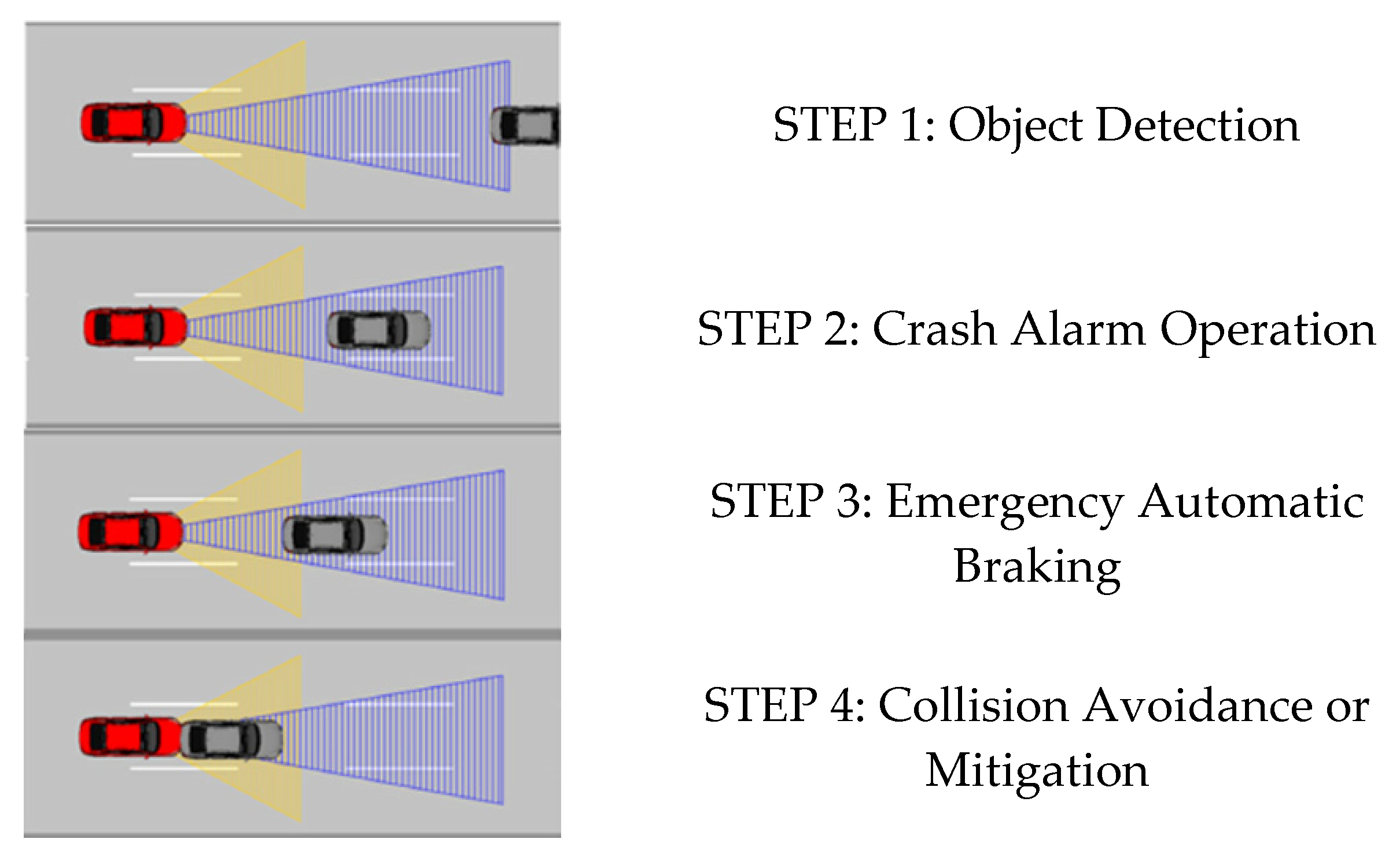
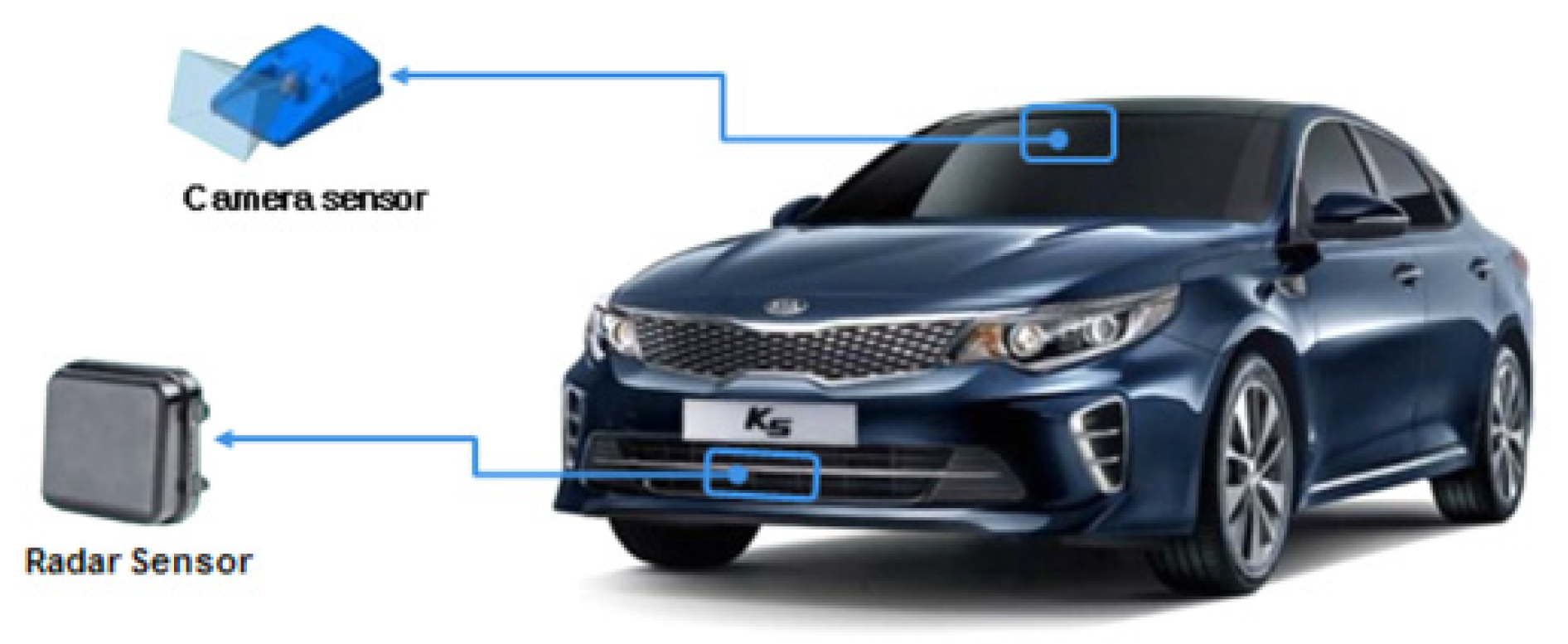
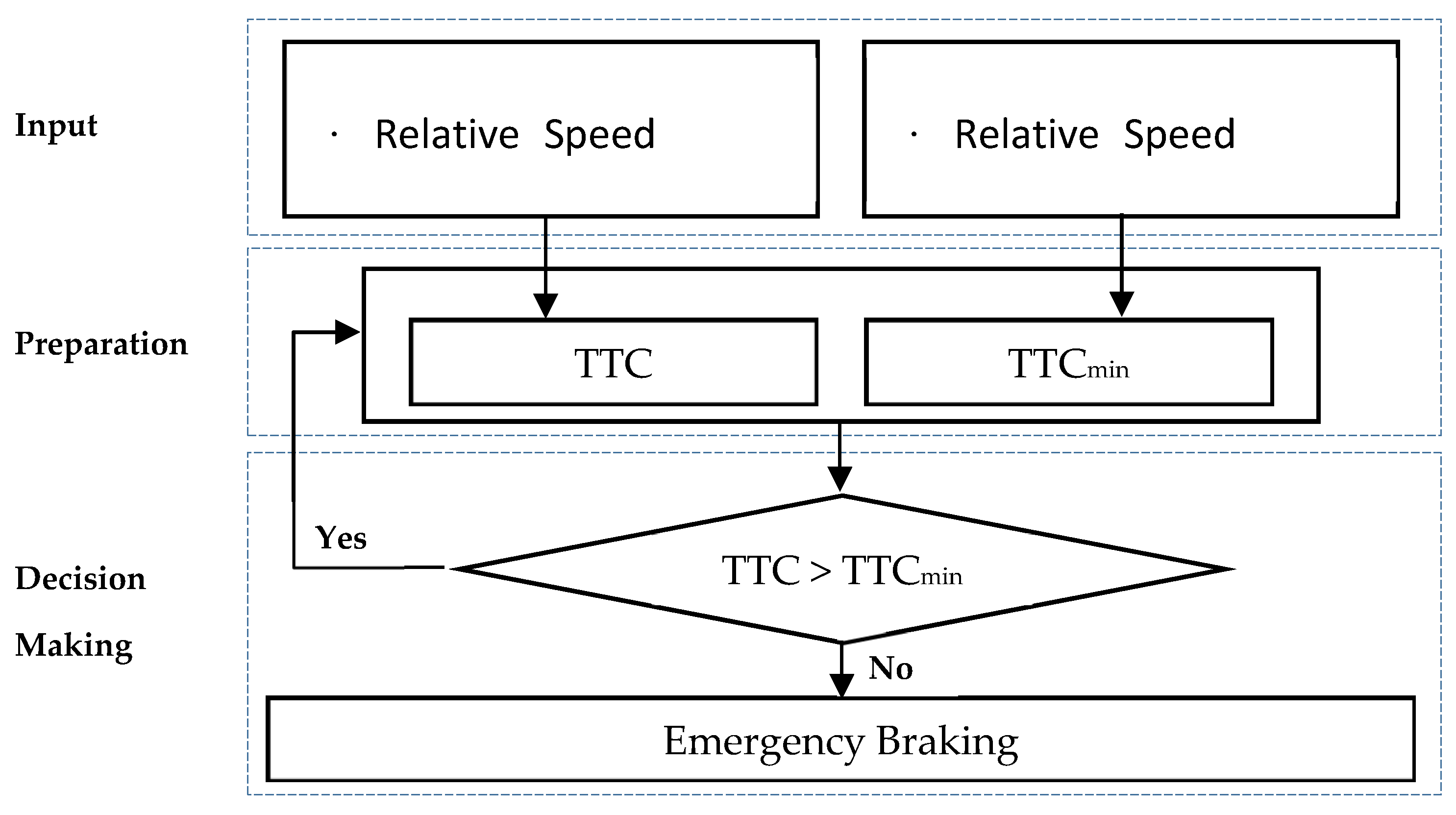
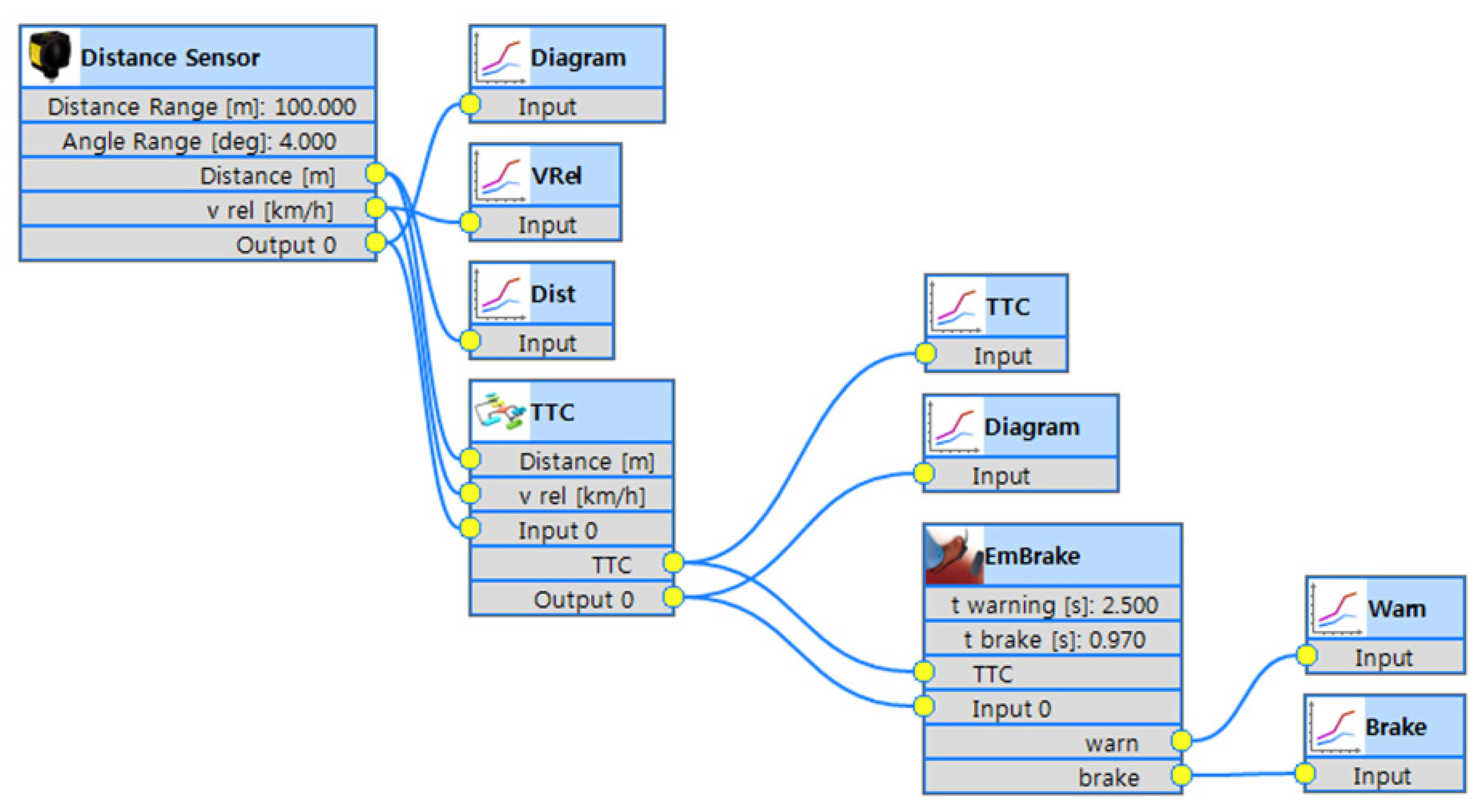

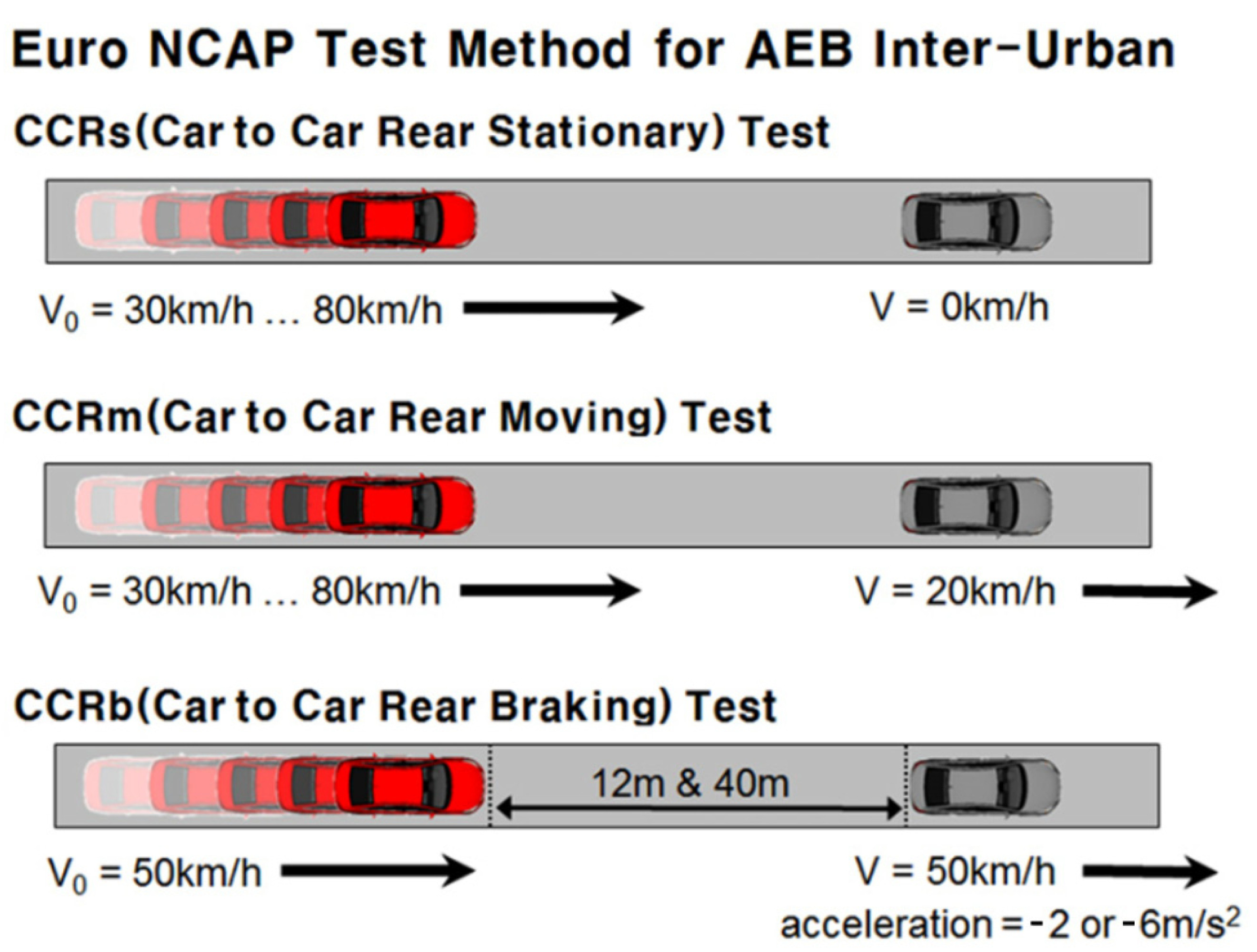
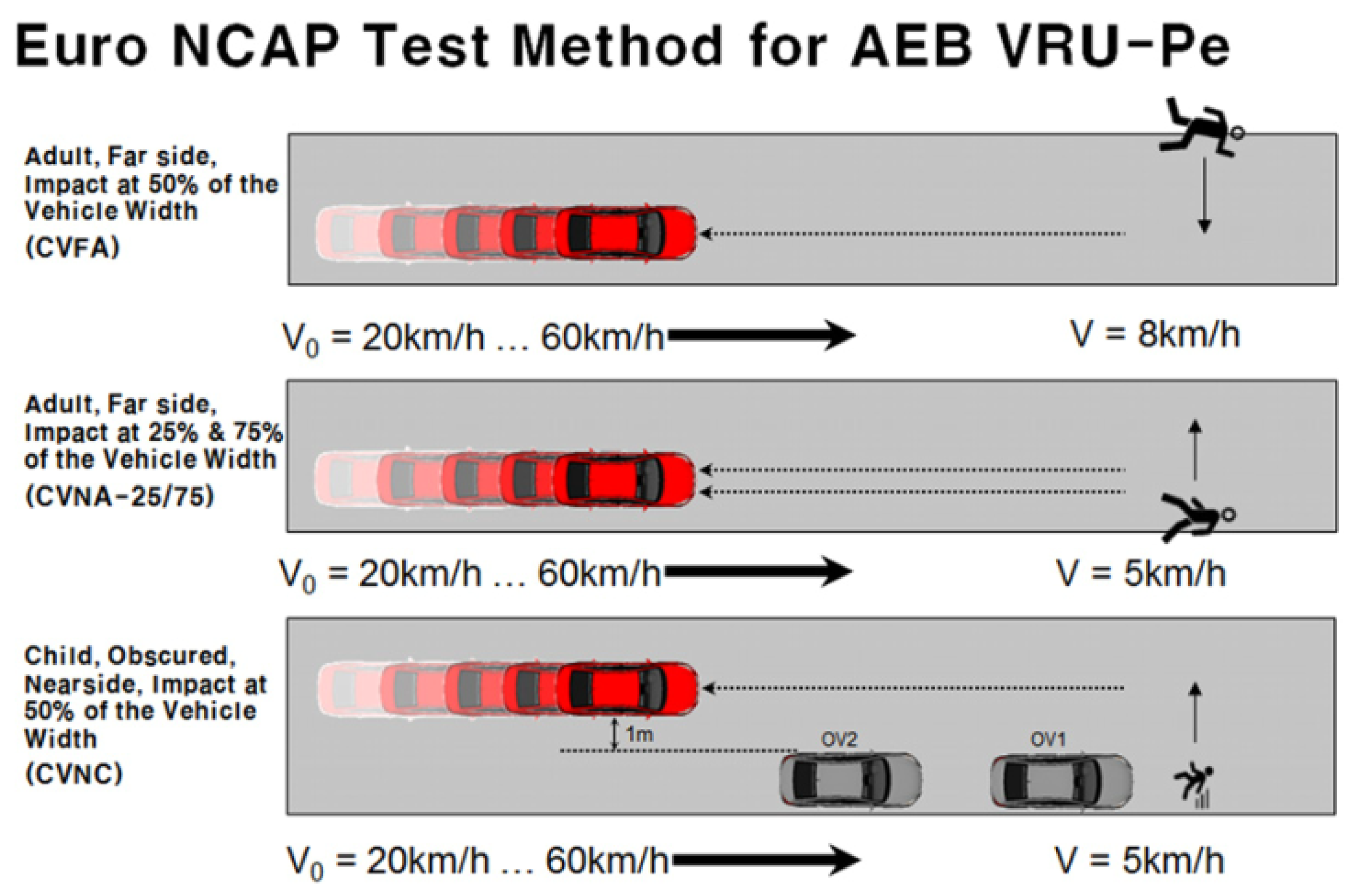
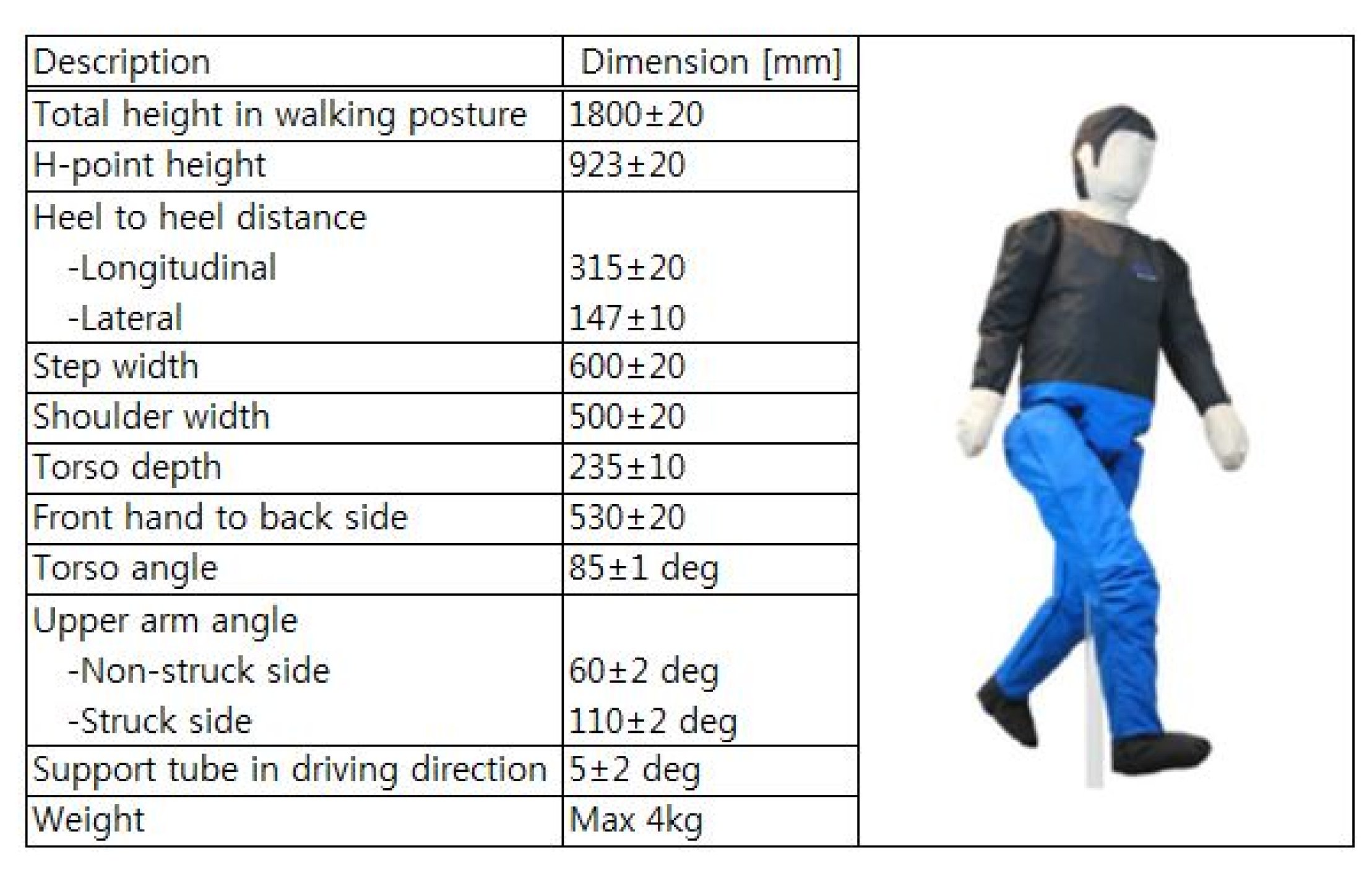
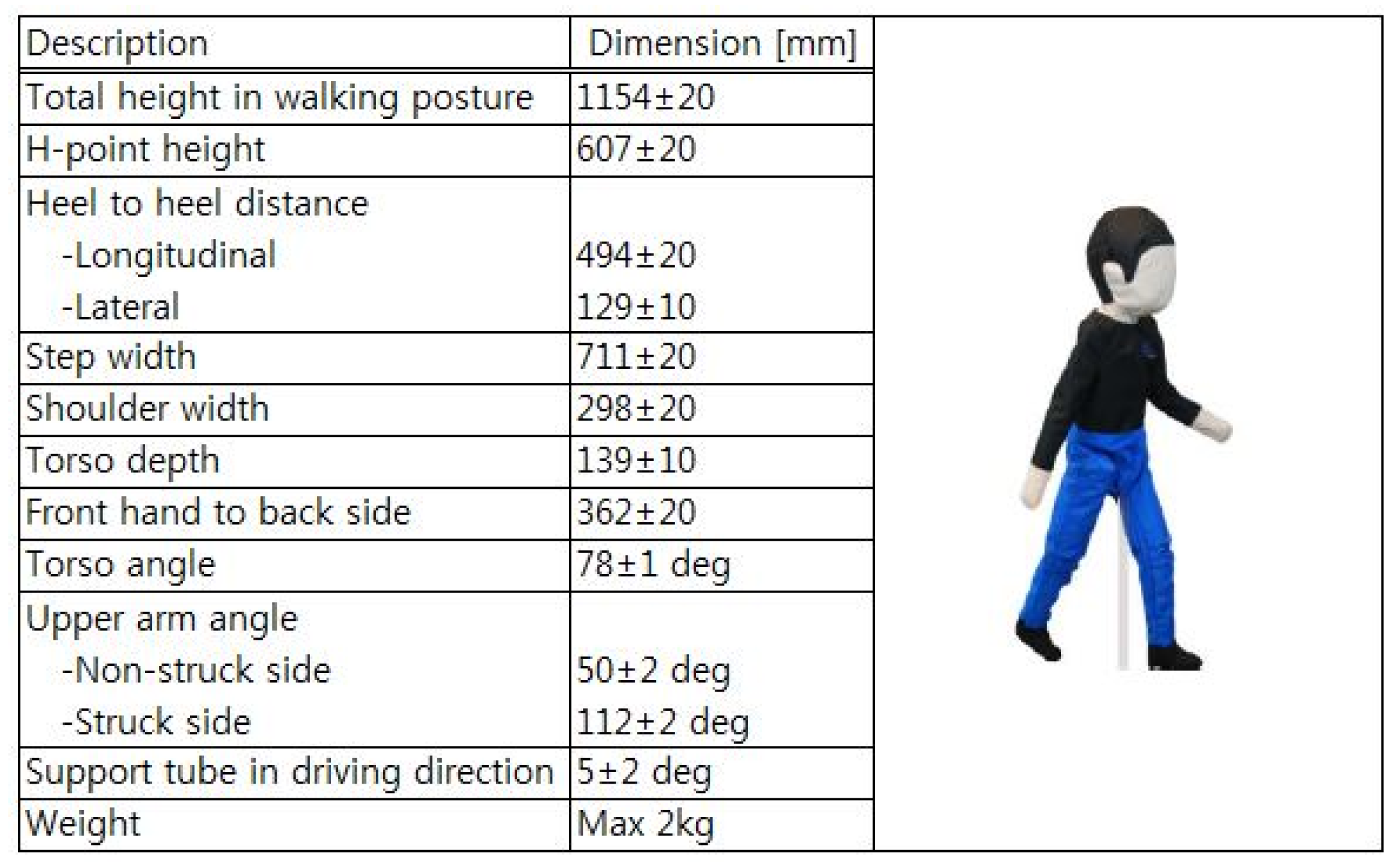
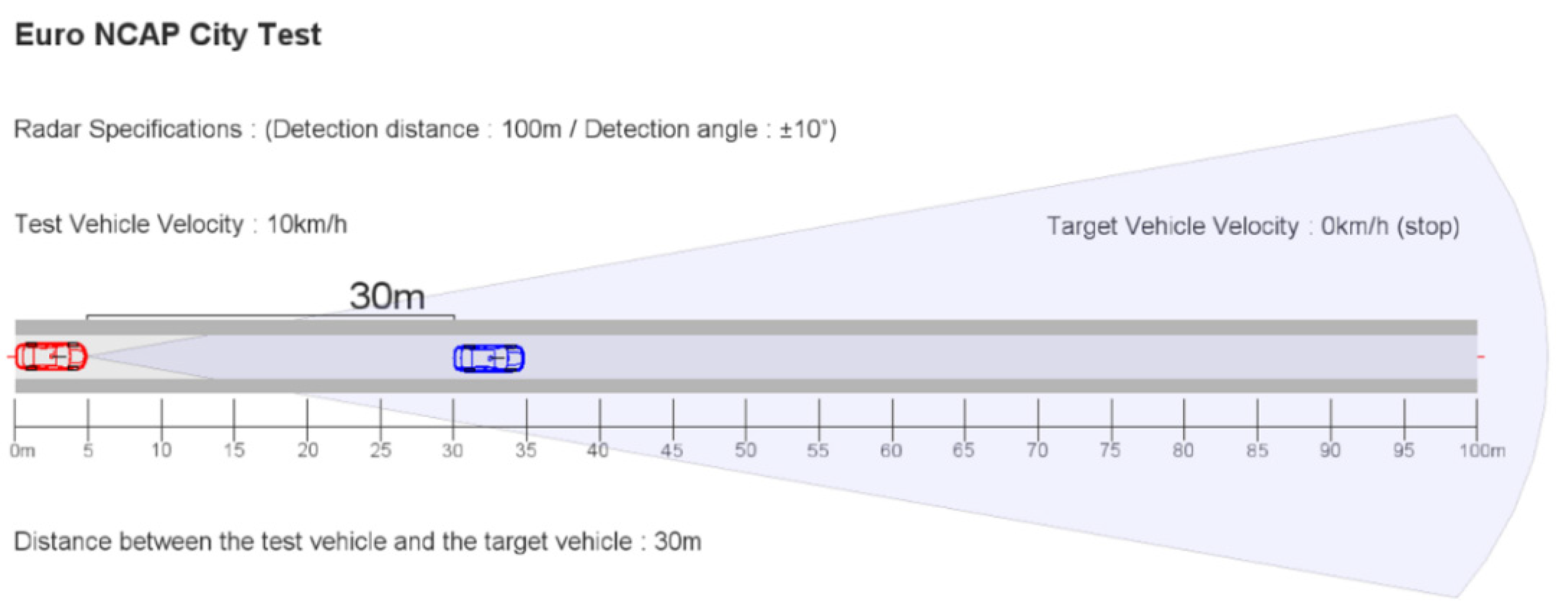
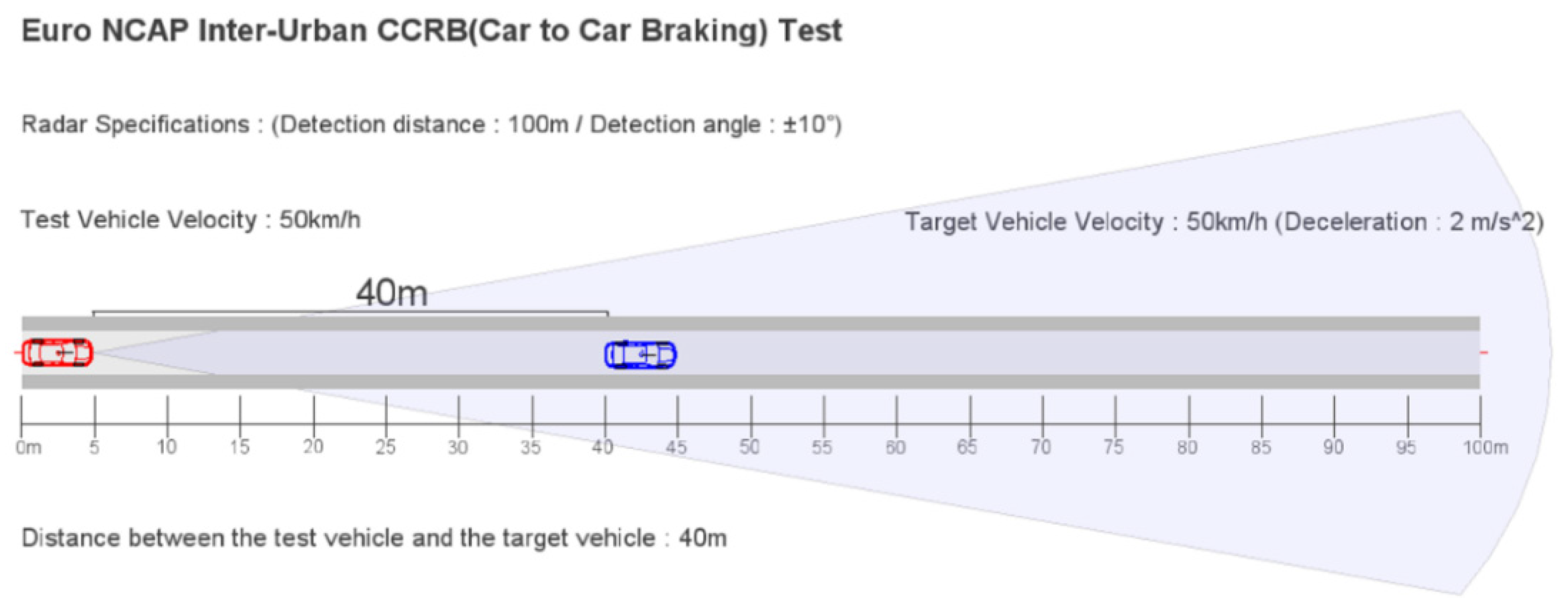

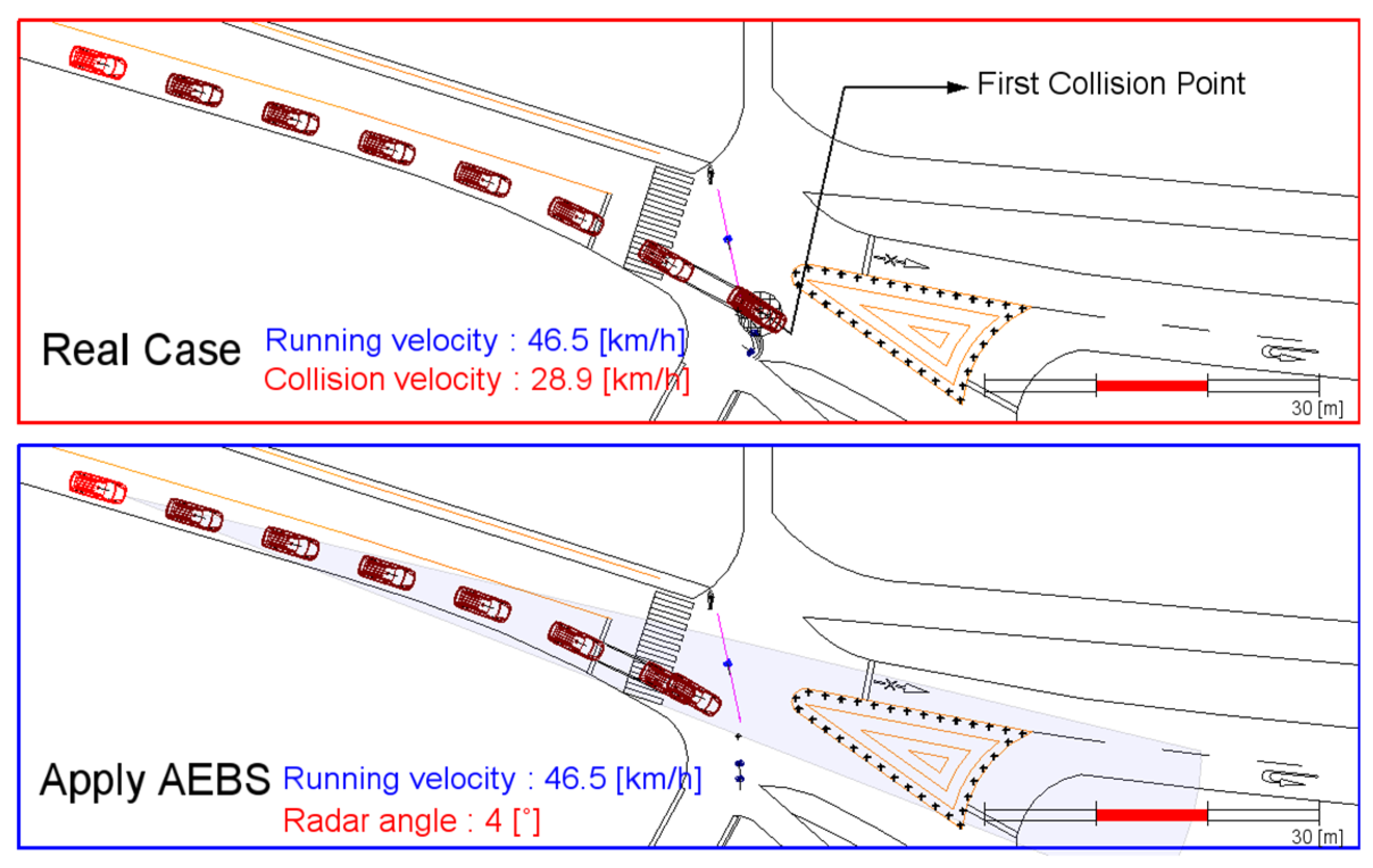
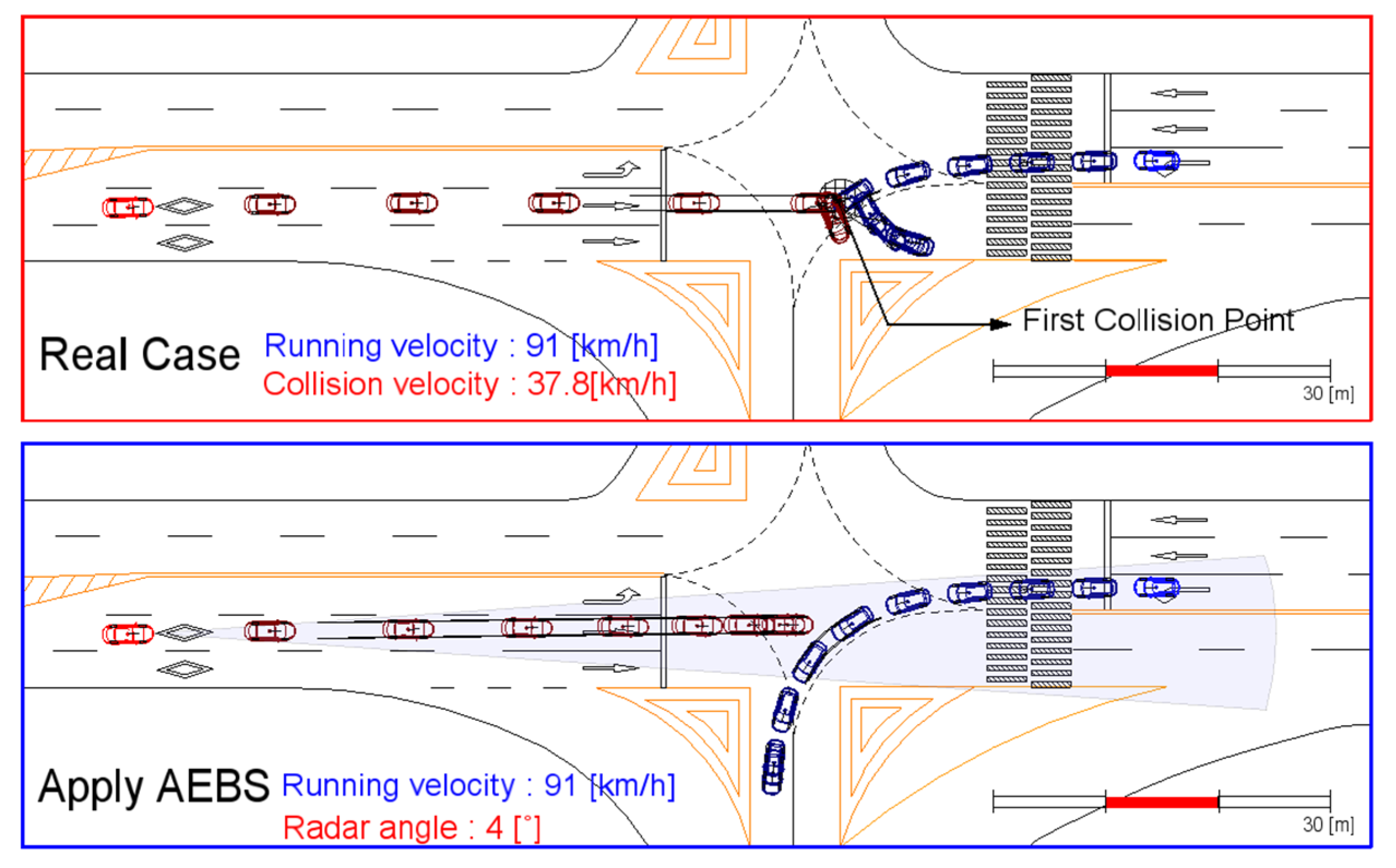
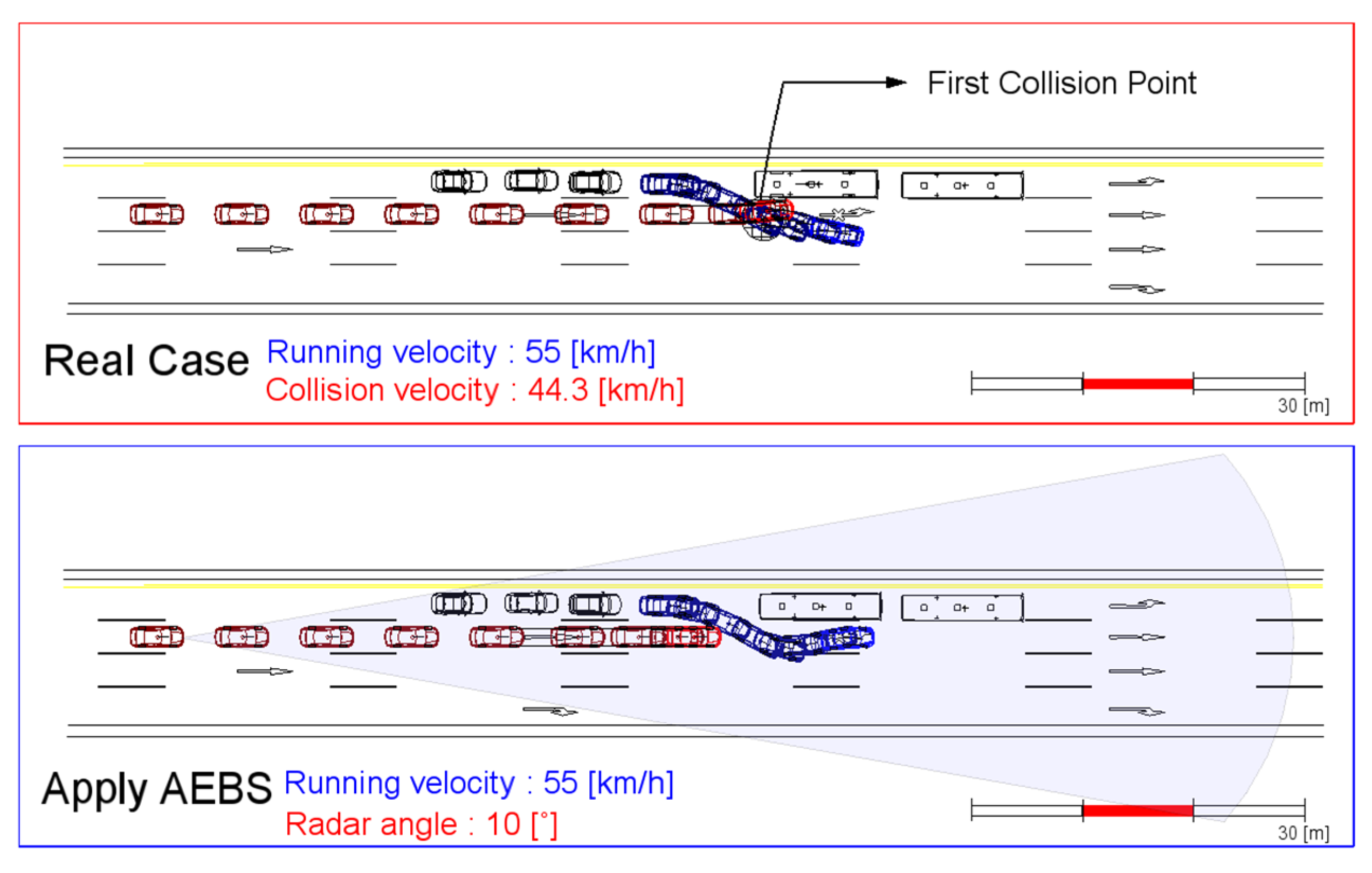



| Maker | Fujitsu | ADC | Delphi | Bosch | Honda Elesys | Denso | Hitachi | Mando |
|---|---|---|---|---|---|---|---|---|
| Image |  |  |  |  |  |  |  |  |
| Detectable Distance (m) | ≤120 | ≤150 | ≤150 | ≤120 | ≤100 | ≤150 | ≤150 | ≤200 |
| Detectable Angle (°) | ±8 | ±5 | ±5 | ±4 | ±8 | ±10 | ±8 | ±10 |
| Radar Angle (°) | 4 | 6 | 8 | 10 | |
|---|---|---|---|---|---|
| Speed (Km/h) | |||||
| 10 | ○ | ○ | ○ | ○ | |
| 15 | ○ | ○ | ○ | ○ | |
| 20 | ○ | ○ | ○ | ○ | |
| 25 | ○ | ○ | ○ | ○ | |
| 30 | ○ | ○ | ○ | ○ | |
| 35 | ○ | ○ | ○ | ○ | |
| 40 | ○ | ○ | ○ | ○ | |
| 45 | ○ | ○ | ○ | ○ | |
| 50 | ○ | ○ | ○ | ○ | |
| CCRs | CCRm | CCRb | |||||||||||||||||||||||
|---|---|---|---|---|---|---|---|---|---|---|---|---|---|---|---|---|---|---|---|---|---|---|---|---|---|
| 12 m, 2 m/s2 | 12 m, 6 m/s2 | 40 m, 2 m/s2 | 40 m, 6 m/s2 | ||||||||||||||||||||||
| Radar Angle (°) | 4 | 6 | 8 | 10 | 4 | 6 | 8 | 10 | 4 | 6 | 8 | 10 | 4 | 6 | 8 | 10 | 4 | 6 | 8 | 10 | 4 | 6 | 8 | 10 | |
| Speed (Km/h) | |||||||||||||||||||||||||
| 30 | ○ | ○ | ○ | ○ | ○ | ○ | ○ | ○ | N/A | N/A | N/A | N/A | N/A | N/A | N/A | N/A | N/A | N/A | N/A | N/A | N/A | N/A | N/A | N/A | |
| 35 | ○ | ○ | ○ | ○ | ○ | ○ | ○ | ○ | N/A | N/A | N/A | N/A | N/A | N/A | N/A | N/A | N/A | N/A | N/A | N/A | N/A | N/A | N/A | N/A | |
| 40 | ○ | ○ | ○ | ○ | ○ | ○ | ○ | ○ | N/A | N/A | N/A | N/A | N/A | N/A | N/A | N/A | N/A | N/A | N/A | N/A | N/A | N/A | N/A | N/A | |
| 45 | ○ | ○ | ○ | ○ | ○ | ○ | ○ | ○ | N/A | N/A | N/A | N/A | N/A | N/A | N/A | N/A | N/A | N/A | N/A | N/A | N/A | N/A | N/A | N/A | |
| 50 | ○ | ○ | ○ | ○ | ○ | ○ | ○ | ○ | ○ | ○ | ○ | ○ | 14 | 14 | 14 | 14 | ○ | ○ | ○ | ○ | ○ | ○ | ○ | ○ | |
| 55 | ○ | ○ | ○ | ○ | ○ | ○ | ○ | ○ | N/A | N/A | N/A | N/A | N/A | N/A | N/A | N/A | N/A | N/A | N/A | N/A | N/A | N/A | N/A | N/A | |
| 60 | ○ | ○ | ○ | ○ | ○ | ○ | ○ | ○ | N/A | N/A | N/A | N/A | N/A | N/A | N/A | N/A | N/A | N/A | N/A | N/A | N/A | N/A | N/A | N/A | |
| 65 | ○ | ○ | ○ | ○ | ○ | ○ | ○ | ○ | N/A | N/A | N/A | N/A | N/A | N/A | N/A | N/A | N/A | N/A | N/A | N/A | N/A | N/A | N/A | N/A | |
| 70 | ○ | ○ | ○ | ○ | ○ | ○ | ○ | ○ | N/A | N/A | N/A | N/A | N/A | N/A | N/A | N/A | N/A | N/A | N/A | N/A | N/A | N/A | N/A | N/A | |
| 75 | ○ | ○ | ○ | ○ | ○ | ○ | ○ | ○ | N/A | N/A | N/A | N/A | N/A | N/A | N/A | N/A | N/A | N/A | N/A | N/A | N/A | N/A | N/A | N/A | |
| 80 | ○ | ○ | ○ | ○ | ○ | ○ | ○ | ○ | N/A | N/A | N/A | N/A | N/A | N/A | N/A | N/A | N/A | N/A | N/A | N/A | N/A | N/A | N/A | N/A | |
| CVFA | CVNA | CVNC | |||||||||||||||
|---|---|---|---|---|---|---|---|---|---|---|---|---|---|---|---|---|---|
| 25% | 75% | ||||||||||||||||
| Radar Angle (°) | 4 | 6 | 8 | 10 | 4 | 6 | 8 | 10 | 4 | 6 | 8 | 10 | 4 | 6 | 8 | 10 | |
| Speed (Km/h) | |||||||||||||||||
| 20 | 14 | 12 | 10 | ○ | x | x | 17 | ○ | ○ | ○ | ○ | ○ | 6 | ○ | ○ | ○ | |
| 25 | 18 | 17 | 14 | ○ | x | 23 | 21 | ○ | ○ | ○ | ○ | ○ | 11 | ○ | ○ | ○ | |
| 30 | 24 | 21 | 17 | ○ | x | 28 | 21 | ○ | ○ | ○ | ○ | ○ | 15 | ○ | ○ | ○ | |
| 35 | 28 | 25 | 19 | ○ | x | 33 | ○ | ○ | ○ | ○ | ○ | ○ | 19 | ○ | ○ | ○ | |
| 40 | 33 | 29 | 18 | ○ | x | 36 | ○ | ○ | ○ | ○ | ○ | ○ | 21 | ○ | ○ | ○ | |
| 45 | 38 | 33 | ○ | ○ | x | 34 | ○ | ○ | ○ | ○ | ○ | ○ | 22 | ○ | ○ | ○ | |
| 50 | 42 | 35 | ○ | ○ | x | ○ | ○ | ○ | ○ | ○ | ○ | ○ | 20 | ○ | ○ | ○ | |
| 55 | 46 | 36 | ○ | ○ | x | ○ | ○ | ○ | ○ | ○ | ○ | ○ | ○ | ○ | ○ | ○ | |
| 60 | 51 | 34 | ○ | ○ | x | ○ | ○ | ○ | ○ | ○ | ○ | ○ | ○ | ○ | ○ | ○ | |
| Type | SN | Vw/o (km/h) | Variable_1 AEBS | Vw/o (km/h) | Variable_2 AEBS | ||||||
|---|---|---|---|---|---|---|---|---|---|---|---|
| 4 | 6 | 8 | 10 | 4 | 6 | 8 | 10 | ||||
| Intersection | 1 | 48 | 47 | 46 | 46 | 45 | 26 | N/A | N/A | N/A | N/A |
| 2 | 46 | N/A | N/A | N/A | N/A | 48 | 38 | 38 | 37 | 36 | |
| 3 | 40 | ○ | 91 | ○ | ○ | ○ | ○ | ||||
| 4 | 53 | ○ | ○ | ○ | ○ | 16 | N/A | N/A | N/A | N/A | |
| 5 | 57 | N/A | N/A | N/A | N/A | 30 | 27 | 27 | 27 | 27 | |
| 6 | 20 | 14 | 13 | 13 | 13 | 48 | N/A | N/A | N/A | N/A | |
| 7 | 50 | 48 | 47 | 45 | 45 | 35 | 34 | 34 | 33 | 33 | |
| 8 | 18 | N/A | N/A | N/A | N/A | 30 | 26 | 25 | 24 | 23 | |
| 9 | 22 | N/A | N/A | N/A | N/A | 66 | 60 | 59 | 58 | 57 | |
| 10 | 35 | 27 | 27 | 26 | 26 | 37 | N/A | N/A | N/A | N/A | |
| 11 | 17 | N/A | N/A | N/A | N/A | 43 | 23 | 22 | 20 | 16 | |
| 12 | 15 | N/A | N/A | N/A | N/A | 60 | 42 | 37 | 27 | ○ | |
| 13 | 37 | N/A | N/A | N/A | N/A | 40 | 31 | 31 | 30 | 29 | |
| 14 | 53 | N/A | N/A | N/A | N/A | 67 | 55 | 54 | 53 | 52 | |
| 15 | 36 | 22 | 22 | 22 | 22 | 20 | N/A | N/A | N/A | N/A | |
| Pedestrian | 16 | 87 | ○ | ○ | ○ | ○ | 6 | N/A | N/A | N/A | N/A |
| 17 | 46 | ○ | ○ | ○ | ○ | 5 | N/A | N/A | N/A | N/A | |
| 18 | 36 | ○ | ○ | ○ | ○ | 6 | N/A | N/A | N/A | N/A | |
| 19 | 80 | ○ | ○ | ○ | ○ | 8 | N/A | N/A | N/A | N/A | |
| Rear-End | 20 | 70 | ○ | ○ | ○ | ○ | 15 | N/A | N/A | N/A | N/A |
| 21 | 76 | ○ | ○ | ○ | ○ | 0 | N/A | N/A | N/A | N/A | |
| 22 | 60 | ○ | ○ | ○ | ○ | 0 | N/A | N/A | N/A | N/A | |
| 23 | 23 | N/A | N/A | N/A | N/A | 67 | ○ | ○ | ○ | ○ | |
| 24 | 36 | ○ | ○ | ○ | ○ | 22 | N/A | N/A | N/A | N/A | |
| 25 | 46 | ○ | ○ | ○ | ○ | 40 | ○ | ○ | ○ | ○ | |
| Lane Change | 26 | 30 | N/A | N/A | N/A | N/A | 30 | 30 | 30 | 29 | 26 |
| 27 | 42 | N/A | N/A | N/A | N/A | 25 | 25 | 25 | 25 | 25 | |
| 28 | 55 | N/A | N/A | N/A | N/A | 44 | 44 | 44 | 44 | 44 | |
| 29 | 34 | 34 | 34 | 34 | 34 | 43 | N/A | N/A | N/A | N/A | |
| 30 | 27 | 27 | 27 | 27 | 26 | 41 | N/A | N/A | N/A | N/A | |
| Type | Case No. | Radar Angle (°) |
|---|---|---|
| Intersection | 1 | 12 |
| 2 | 18 | |
| 3_Veh 1 | 4 | |
| 3_Veh 2 | 4 | |
| 4 | 4 | |
| 5 | 13 | |
| 6 | 25 | |
| 7 | 24 | |
| 8 | 25 | |
| 9 | 23 | |
| 10 | 29 | |
| 11 | 25 | |
| 12_Veh 1 | 29 | |
| 12_Veh 2 | 50 | |
| 13 | 39 | |
| 14_Veh 1 | 18 | |
| 14_Veh 2 | 10 | |
| 15_Veh 1 | 50 | |
| 15_Veh 2 | 12 |
Publisher’s Note: MDPI stays neutral with regard to jurisdictional claims in published maps and institutional affiliations. |
© 2021 by the authors. Licensee MDPI, Basel, Switzerland. This article is an open access article distributed under the terms and conditions of the Creative Commons Attribution (CC BY) license (http://creativecommons.org/licenses/by/4.0/).
Share and Cite
Choi, Y.; Baek, S.; Kim, C.; Yoon, J.; Lee, S.M. Simulation of AEBS Applicability by Changing Radar Detection Angle. Appl. Sci. 2021, 11, 2305. https://doi.org/10.3390/app11052305
Choi Y, Baek S, Kim C, Yoon J, Lee SM. Simulation of AEBS Applicability by Changing Radar Detection Angle. Applied Sciences. 2021; 11(5):2305. https://doi.org/10.3390/app11052305
Chicago/Turabian StyleChoi, Yongsoon, Seryong Baek, Cheonho Kim, Junkyu Yoon, and Seongkwan Mark Lee. 2021. "Simulation of AEBS Applicability by Changing Radar Detection Angle" Applied Sciences 11, no. 5: 2305. https://doi.org/10.3390/app11052305
APA StyleChoi, Y., Baek, S., Kim, C., Yoon, J., & Lee, S. M. (2021). Simulation of AEBS Applicability by Changing Radar Detection Angle. Applied Sciences, 11(5), 2305. https://doi.org/10.3390/app11052305






